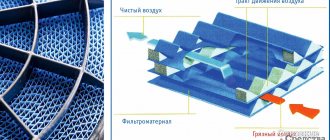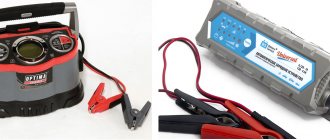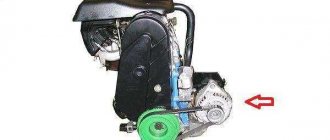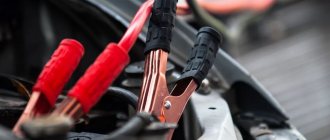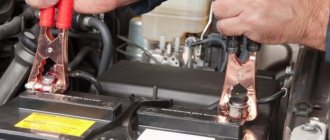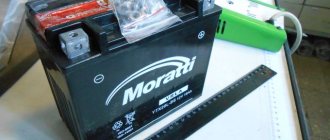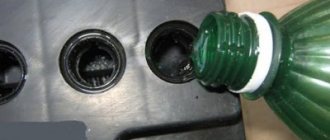What is an autonomous and compact battery charger and its purpose?
The independent starting device consists of a built-in energy storage device in the form of lithium polymer batteries. They are able to supply energy both to recharge the engine (slowly) and to start it (fast). Conventionally, boosters are divided into two groups: pocket and “battery suitcases”.
Bulk “power banks” are usually equipped with classic lead-acid batteries or AGM batteries, which are used in start/stop systems. It is difficult to call such current generators compact; nevertheless, a portable starting and charger for a car is in great demand and reviews confirm this. Most mobile models claim a starting current of 200-300 A (and peak values reach 400-600 A). Actually, this is enough to start an internal combustion engine with a volume of up to two liters, but how do the numbers correspond to reality?
Energy source
As already mentioned, the majority of compact devices are equipped with lithium-polymer cells. Similar energy sources are used in tablets and smartphones. Structurally, the batteries are made in the form of rectangular plates. The parameters of each of them are expressed by the following numbers:
- Rated voltage – 3.7 V.
- The voltage in the charged state is 4.2 V.
- The voltage when discharged is 3 V.
A deep discharge, just like overcharging, can damage the element. Therefore, three series-connected batteries occupy only 2/3 of the device body. The rest of the space is intended for electronics - controllers, converters and other parts.
Briefly about capacity
When choosing a booster, as in the case of buying a battery, we pay attention to the capacity. Of course, this characteristic is very important, but you should rely on it with some caution. The numbers in ampere-hours show primarily the amount of electrical charge and only partially characterize the actual capacity of the batteries.
For most launchers presented in the review, the capacitive parameters are not indicated quite correctly. This is due to the fact that the ampere-hour values are directly related to the magnitude of the voltage under certain conditions. For example, a stand-alone charger with a minimum voltage of 3.7 V can have a capacity of 15 Ah, and when charging a smartphone via a five-volt USB port, it will be less.
Important! To find out the actual capacity at 5 V, you need to calculate the absolute capacity (15,000 mAh x 3.7 V = 55,500 mWh) and divide it by the voltage at the USB output: 55,500 mWh / 5 V = 11,000 mAh. When charging phones, this is the parameter you need to focus on. Taking into account various losses ranging from 14-20%, the booster should be enough for 4-5 charges of a smartphone with a 2000 mAh battery.
The picture is completely different when starting the engine - electricity will be removed through the wires. At 12 V the capacity will be 4583 mAh. Some owner reviews on this matter note a small cross-section of the wires, but expert Mikhail Kolodochkin reassures them to some extent:
“Even a novice motorist understands that thin connecting wires are not suitable for transmitting starter currents. Hence all the doubts. But few people take into account their length, and the booster has short ones. This means that the resistance of the wires is small. Although they heat up quite noticeably when starting up, they still work!
Test technology
It was decided to check the performance of the devices without special measurements of voltages and charging currents. Testing took place on a classic VAZ 10 with a 1.5 liter engine, but with a previously discharged battery. The basic conditions for testing autonomous small-sized starting and charging devices are as follows:
- Ambient temperature is about 0°C.
- The duration of discharges with inrush current is 10 seconds.
- Number of discharges – 3 (with minute intervals).
- The duration of peak current discharges is 3 seconds with one discharge.
As a result, all the gadgets cheerfully turned the starter and revived the engine with a completely discharged battery. However, energy reserves, as one might expect, turned out to be different. However, to the great joy of motorists, you can forget about the lighting procedure. And this is already a lot, since today rarely anyone lets them light a cigarette for fear of damaging the car’s electronics.
How to use
Before using the liquid, be sure to read the instructions, since the method of using the product for different types of engines has its own characteristics. Engines can be diesel or gasoline (carburetor or injection).
In general, the procedure for starting the engine is quite simple:
- It is necessary to shake the container with the product well.
- Spray the mixture into the intake manifold pipe for 2-3 seconds.
- Start the engine. If the car is in good working order, it will start immediately.
In cars with gasoline engines, the spray can be sprayed into the air filter or directly into the carburetor. In diesel engines, you must first open the throttle by pressing the gas pedal.
It is more convenient to work with an assistant: one sprays the aerosol, the other starts the car. If the car does not start after two attempts, you need to take a break or abandon this method.
Top rating of the best portable battery chargers for cars
As a rule, the longer a brand has been on the market, the higher the quality of its products. Producing startup ROMs requires high-tech manufacturing, which little-known companies cannot afford. Therefore, the level of technical development of the company cannot be neglected.
We must not forget about providing warranty and post-warranty service. Well-known manufacturers in most cases provide the client with the opportunity to replace a faulty device.
When forming the top list, not only technical characteristics were taken into account, but also the presence of integrated protection systems. The number of protective functions significantly affects the price, but a good booster, by definition, cannot be cheap. The level of equipment also had a significant impact on the placement of positions.
Carku E-Power 21
The most durable unit that has demonstrated high energy capabilities. The only downside is the price, which is one of the highest among analogues. The declared starting current is 300 A, and its peak values are around 600 A.
However, it is worth noting that not every rating of portable jump starters takes into account the true purpose of the launcher. After all, this is not the main battery, but just an assistant, and demanding from it the functions of a full-fledged battery is not entirely correct.
In three ten-second starts, the voltage at the device terminals did not drop below 9.18 V. This is a very impressive result. True, after the tests the product became noticeably hot, and one crocodile even had a tooth burnt out. But let's not forget that the manufacturer, who promised a dozen starts without recharging, did not at all mean 10 seconds of torture with each of them.
The unit comes with not only a nice velvet case and a bag for transportation, but many other useful accessories:
- Adapters for charging from the cigarette lighter and 220 V mains.
- Adapters for charging mobile electronics and laptops.
- Smart wires with clamps for connecting the ROM to the battery.
- Female cigarette lighter adapter for connecting 12-volt devices.
ParkCity GP 24
One of the few devices that has the ability to start a car without a battery. Outwardly it looks like a professional device - a massive body with a characteristic black and yellow color. The mode, state of charge and state of the unit (discharge, overheating, testing, etc.) are displayed on a monochrome screen. In addition, the booster has a number of useful functions:
- Monitoring the charge of the standard battery and the output voltage of the generator through the cigarette lighter socket.
- Overload and short circuit protection.
- Availability of Engine Start and Override modes: the first is used by the booster if the voltage at the terminals of the standard battery is more than 2 V, the second - when the potential is less than 2 V.
- Two USB ports for charging smartphones and laptops provide 2.4 A at 5 V.
Numerous reviews of the ParkCity GP 24 portable battery charger for a car note the solid capacity of its battery – 10,400 mAh.
The starting current is stated to be 270 A, and the peak current is 400 A. After the first attempt, the charge level of the starter decreased by 11%. The second launch consumed another 12% of the charge. The third time, the booster cranked the starter for 5 seconds and went into overload mode - the screen showed 50% of the charging potential. After 30 minutes, the device was again ready for use, but after a couple of seconds it turned off and went into a cooling state. But the USB ports continued to work and charge gadgets.
Neoline Jump Starter 500A
A powerful jump starter with a capacity of 10,400 mAh, even at low air temperatures, easily produced the current necessary to start the engine. However, the energy reserve is small - the ampere hours turned out to be almost half as low as those declared by the manufacturer. The rated starting current is 200 A, the peak current reaches 500 A.
The functionality of the device is quite extensive:
- Possibility of starting gasoline internal combustion engines with a volume of up to 6.5 liters, diesel engines with a volume of up to 3.5 liters.
- Smart Clamps power clamps with protection based on MOSFET field-effect transistors.
- A complex of built-in protection against deep discharge, reverse current, overheating, polarity reversal and short circuit.
If the display shows the level of charge of the unit is more than 75%, then you can start starting. But before that, we look at the power cable indicators of the autonomous multifunctional starter-charger: a green LED signals readiness for operation, and a red LED with an additional sound signal indicates that the protection has tripped.
The first engine start reduced the booster charge by 12%, the second - by 8%. The indicator already showed 76% charge, while the manufacturer recommends not using the device at 75%. However, for the purity of the experiment, a third launch was carried out. After it the charge was 68%.
In addition to the protective case, the unit includes a cable for charging mobile gadgets and chargers for 220 and 12 V.
Precautionary measures
If you follow the safety rules and instructions for using the engine quick start agent (aerosol), no problems should arise.
You must adhere to the following recommendations for use:
- Do not exceed the amount of spray composition specified in the instructions.
- Do not use starting fluid too often.
- Check that the ether matches the engine type of your car (indicated on the can).
- Inject the product at the point indicated in the instructions (for example, into the intake manifold).
- Do not spray the aerosol on spark plugs or any heating elements.
- If work is carried out indoors, good ventilation must be ensured.
- Follow the rules for storing a container with liquid.
By observing these precautions, you can avoid negative consequences when using starting aerosols.
Liquid Mannol "Motor Starter 9669"
The product, produced by a German manufacturer, is a popular and proven product. Thanks to the composition, it is possible to quickly start the engine in winter with minimal side effects. The liquid is economical and easy to use, equipped with a long tube that facilitates access to the installation. Area of application of the liquid: four-stroke engines running on gasoline, diesel, gas. In comparison with the previous product, the minimum temperature of use is -20 degrees, the product is placed in a cylinder with a volume of 450 ml (article 2136).
Why is “Quick Start” dangerous?
It’s worth saying right away that in no case should you exceed the amount of product that can be used according to the instructions. We also note that this composition, which has actively begun to conquer the domestic market, has long been known in Europe. However, they are skeptical about such liquids and prefer to do without them.
The thing is that even though they unanimously claim that their compositions are completely safe, in reality everything turns out to be not so rosy. The main components of the liquid are substances that can ignite in a fraction of seconds, which creates a risk of detonation. Of course, the car will not be smashed to pieces, but there is a high probability that the piston ring may be destroyed. Valves may burn out, cylinder liners and other elements may be damaged.
Important! The composition can cause especially great harm to a diesel engine, since the fuel in it ignites at a higher pressure.
In addition, the liquid contains esters, which very quickly wash away the oil film from the internal surfaces of the cylinders. At the same time, the lubricating components themselves, which are kindly added, are not enough to ensure normal lubrication.
After using the “miracle” liquid, there is a risk that:
- Air filters will be damaged.
- The timing belt will come off.
- The engine connecting rods will be damaged.
- The crankshaft will break.
- The fuel system will fail.
- The low pressure pump will break down.
- The piston will be deformed.
In fairness, it is worth noting that all these “horrors” usually occur in the case of constant use of the composition. If you use it only in the most emergency situations, it will not lead to dire consequences. It is equally important not to buy cheap products and fakes. It is better to give preference to trusted manufacturers.
Negative effects of “Quick Start” on the engine
By provoking an ignition, there is a high probability of seriously harming the car engine. The “Quick Start” product has a greater ability to detonate; accordingly, with early ignition of this mixture, there is a serious dynamic impact on the engine elements, especially on the piston. Depending on the quality of the engine components, the consequences of such an impact may vary.
There are several problems that can result from regular use of “Quick Start” liquid:
Possibility of piston bending as a result of impact;
- Deformation, damage or rupture of piston rings;
- Burnout of valves due to high temperatures;
- Reduced oil performance due to a possible “conflict” of chemical elements in the lubricant component and the “Quick Start” fluid;
- Potential engine overheating and thermal deformation of parts.
Experts recommend not using Quick Start liquid on a regular basis. It is best used in emergency situations when starting the engine is difficult due to low temperatures or as a result of the car being idle for a long time.
( 149 votes, average: 4.55 out of 5)
How many liters of oil to pour into the engine
What kind of fluid is poured into the power steering: colors, characteristics, choice of fluid


